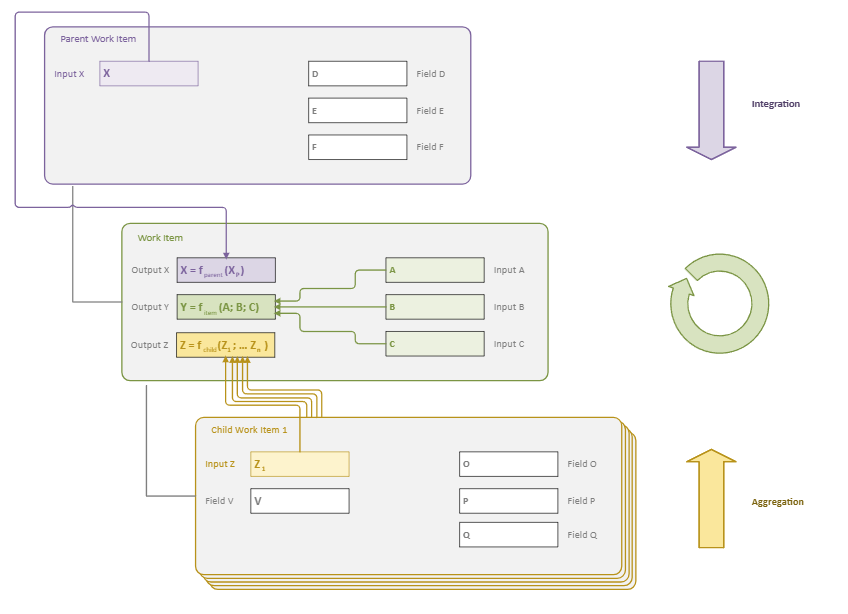With Calculated Fields, the spreadsheet functionality familiar from Excel has also been available for the Orcanos platform since July 2024. The automated consolidation and processing of large volumes of data and the availability of process KPIs in real time are critical challenges in the design control processes of medical technology, where precise data processing and regulatory compliance are simply indispensable.
Basic Architecture and Functionality of Calculated Fields
One of the features we particularly liked when looking at the new functionality is the context-based formula definition. In other words, Calculated Fields works on three hierarchical levels (see figure below).

Calculations are performed in the following ways:
1. Calculations within the fields of a work item by directly accessing the fields of the current item via [*Me.fieldname*]. For example, costs can be calculated from hours worked and hourly rates, or variances between target and actual values.
2. Integration of higher-level data from parent items via [*Parent.Fieldname*]. For example, parameters that are to be used for many child data objects need only be defined once in the parent item, or the child items can be labeled centrally if the data objects are to be evaluated in different queries.
3. Aggregation of child data records by [*Children.Fieldname*]. This is a very powerful feature. It ranges from simply counting the number of objects or summing quantities to searching for extreme values or determining statistical key figures. In conjunction with the embedded filters in the description field of the parent item, the subsets searched for according to the criteria can also be automatically determined and displayed in tabular form.
As you can see from these few examples, this opens up a whole new world of possibilities for dealing with the data. Much more complex or even entirely new information can be visualized in the dashboards, taking real-time monitoring to a whole new level.
Mathematical and statistical operators
- Orcanos currently supports over 40 functions from the following categories in the Calculated Fields:
- Basic arithmetic operations (+, -, *, /, ^)
- Statistical functions (STDEV, STDEVP, COUNT)
- Trigonometric functions (SIN, COS, TAN with radians/conversion)
- Logarithmic functions (LN, LOG10, EXP)
Further functions, such as the if-then function, which supports the aggregation of data under logical criteria, are in preparation. A current list of available functions can be found on this Orcanos page
Implementation
This functionality is currently available for text and numeric data fields. It can be defined in secure administrator mode through the field properties in the eForms Layout Editor. The step-by-step procedure is described on this Orcanos page. Calculated fields are marked with a green fx on the forms and cannot be changed by the application user. The function used for the field is displayed when you move the mouse over the calculated field.
Real-time validation and error handling
As is usual with Orcanos, a multi-level validation concept has also been implemented for the calculated fields:
- Syntax check when entering formulas
- Type compatibility checks (e.g. text vs. numeric fields)
- Runtime error detection such as division by zero
A faulty field, for example, displays the detailed messages, such as:
“Error 204: ‘Patient Weight’ field in parent item is not numeric”
This significantly speeds up the troubleshooting process during the development of the data concepts.
Conclusion and outlook
The Calculated Fields in Orcanos are a powerful tool for managing the complex requirements of medical devices development. Thanks to their deep integration into the ALM workflow, they enable:
- Reduction of manual data maintenance by up to 75
- Real-time compliance monitoring of critical parameters
- Extensive traceability across the entire product lifecycle
The Calculated Fields functions are currently only available in the Professional license package. I think that these functions offer such fundamental enhancement possibilities to the entire platform that Calculated Fields should also be available in the Essential package. This is something that Orcanos should think about again
Future enhancements, such as the If-Then function, also allow data to be consolidated under logical aspects. Combined with machine learning models (Ask Paul), this is a big step in the digital world towards real-time monitoring and evaluation of processes and predicate logic.






